Socio-Ecological Controversies from Chilean and Brazilian Sustainable Energy Transitions
Abstract
1. Introduction
2. Background—Energy Transition and Socio-Ecological Controversies
2.1. Environmental Justice and Ecological Distribution
2.2. Energy Justice
3. Materials and Methods
Study Cases
4. Results—Deepening Justice Issues in the Chilean and Brazilian Energy Transition
4.1. The Chilean Case
4.1.1. A Brief Analysis from the Environmental Justice Perspective
4.1.2. Evaluating Energy Justice
4.2. The Brazilian Case
4.2.1. A Brief Analysis from the Environmental Justice Perspective
4.2.2. Evaluating Energy Justice
5. Discussion
5.1. Some Lessons
5.1.1. A Brief Discussion on Justice and Sustainability in the Energy Transition
5.1.2. The Hydropower Development under Question
5.1.3. What about NCREs?
5.2. Thoughts on Energy Justice—A Normative Analysis
5.3. What about Alternatives Fora Just and Sustainable Energy Transition?
5.3.1. Citizen Engagement and Energy Commons
5.3.2. Energy Communities as an Example of Alternatives Emerging with NCREs
6. Conclusions
7. Further Research Directions
Author Contributions
Funding
Institutional Review Board Statement
Informed Consent Statement
Data Availability Statement
Conflicts of Interest
Abbreviations
| AM | Amazonas |
| AN | Antofagasta |
| ANEEL | Brazilian Electricity Regulatory Agency |
| BA | Bahia |
| BI | Bío Bío |
| CEN | The National Electrical Coordinator |
| EC | Energy Community |
| EJAtlas | Atlas of Environmental Justice |
| ENAP | National Petroleum Company |
| IEA | International Energy Agency |
| ILO | International Labour Organization |
| IO | In operation |
| MG | Minas Gerais |
| MT | Mato Grosso |
| NB | Ñuble |
| NCRE | Nonconventional renewable energy |
| NZE | Net zero emissions |
| PA | Pará |
| PE | Pernambuco |
| RM | Metropolitan |
| RO | Rondônia |
| RS | Río Grande do Sul |
| SC | Santa Catarina |
| SDGs | United Nations’ Sustainable Development Goals |
| SHP | Small-scale hydropower |
| UC | Under construction |
Appendix A. Chilean and Brazilian Power Generation in 2020 by Sources
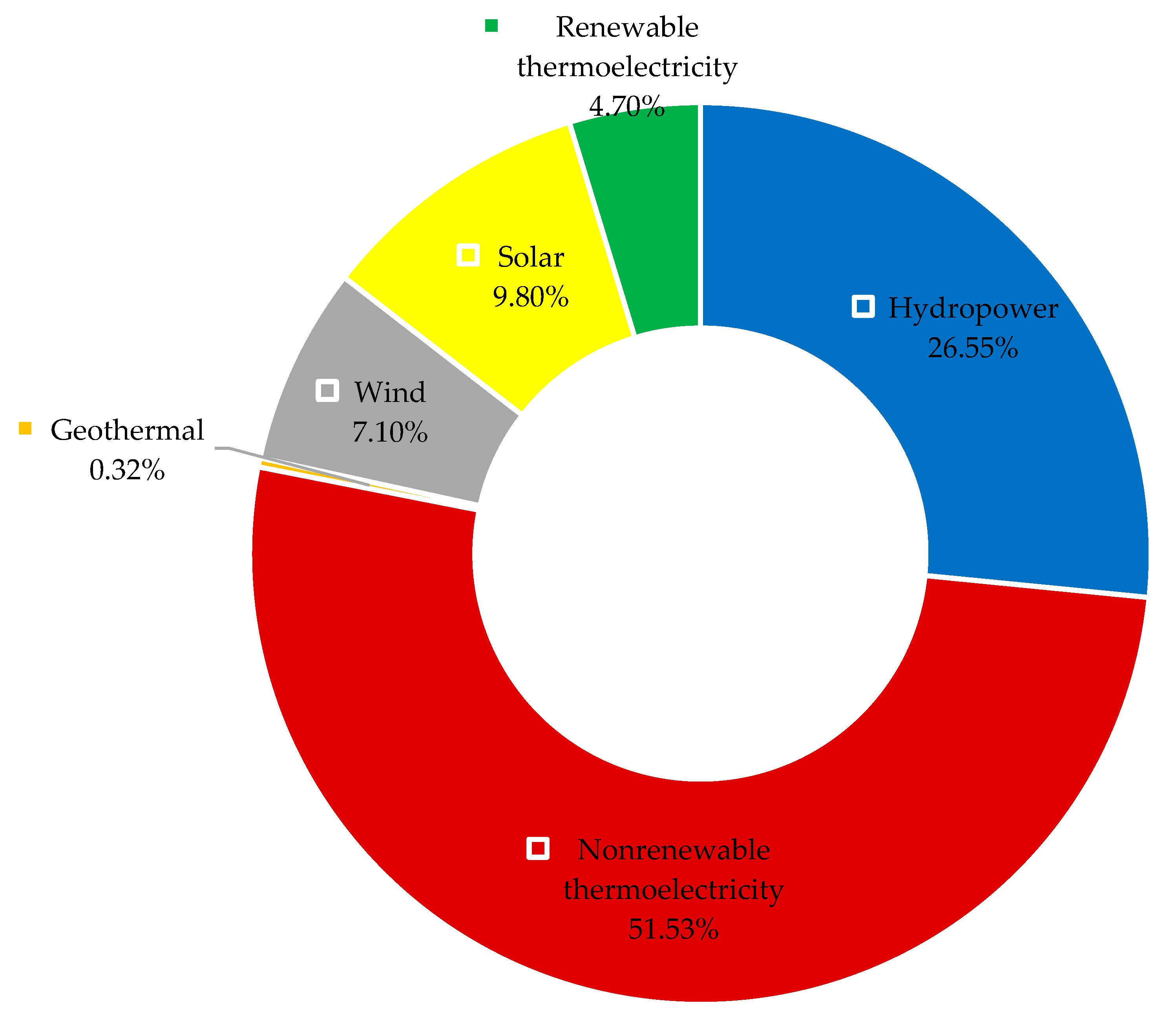
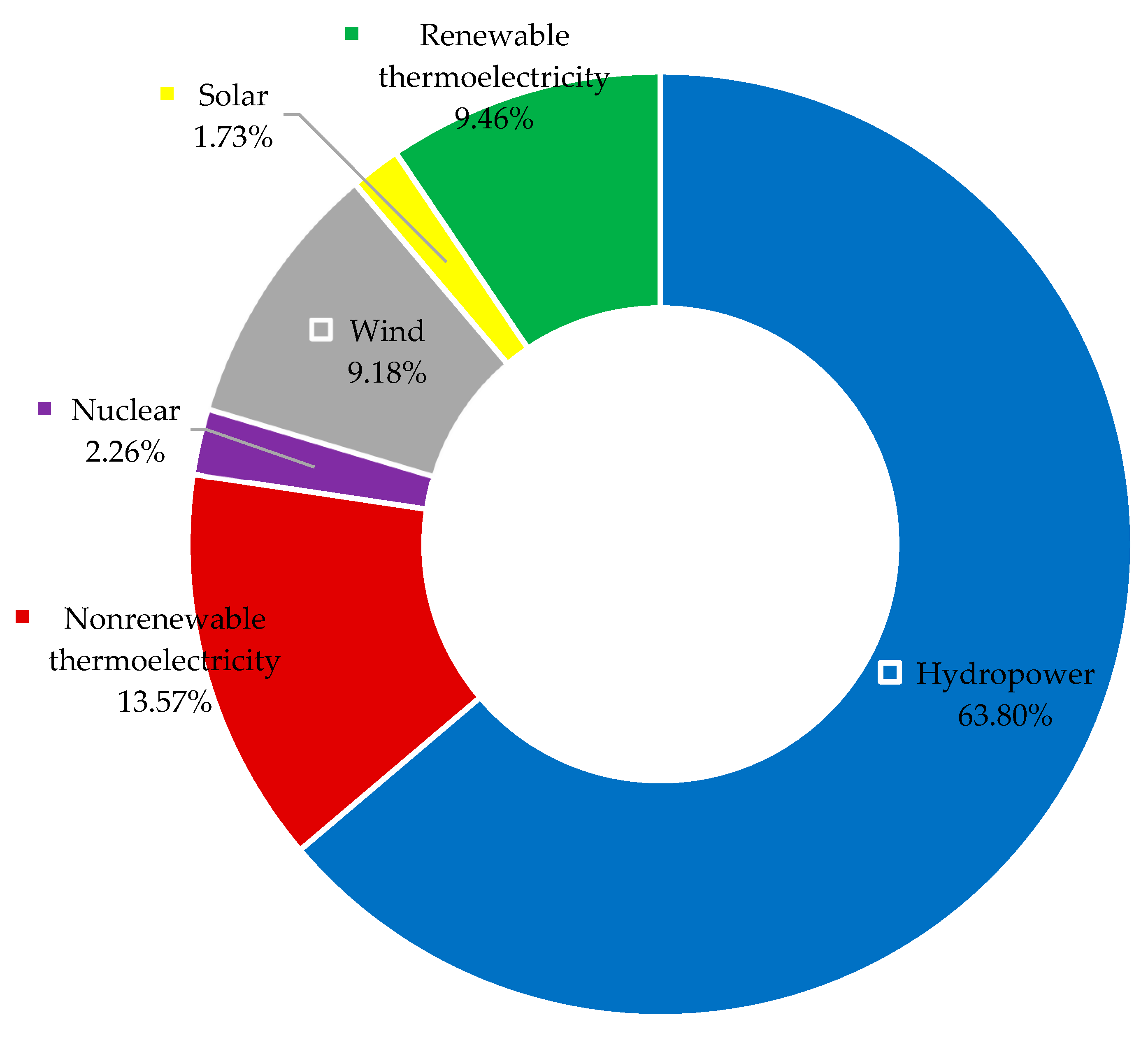
Appendix B. Power Projects with Socio-Ecological Conflicts
| Name | Size (MW) | Status (a) | Source of Conflict | Impacts | Region (b) | Year |
|---|---|---|---|---|---|---|
| Cerro Pabellón (Geothermal) | 51 | IO |
| Socio-economic | AN | 2017 |
| Ralco (Hydropower) | 685 | IO |
| Displacement; loss of livelihood; militarisation; social problems; violations of human rights; land dispossession; loss of landscape | BI | 1996 |
| Angostura (Hydropower) | 321 | IO |
| Biodiversity loss; loss of landscape; deforestation and loss of vegetation cover; surface water pollution; reduced ecological and hydrological connectivity; displacement; loss of traditional knowledge, practices, and cultures; militarisation; land dispossession; loss of landscape | BI | 2014 (c) |
| Alto Maipo—Alfalfal II (Hydropower) | 264 | IO |
| Fires; foods; loss of landscape; noise pollution; deforestation and loss of vegetation cover; increase in corruption and co-opting of different actors; militarisation; violations of human rights | RM | 2007 |
| Alto Maipo-Laja (Hydropower) | 146 | IO | RM | 2007 | ||
| Hidroñuble (Hydropower) | 136 | UC |
| Loss of landscape; soil contamination; deforestation and loss of vegetation cover; surface water pollution; decreasing water quality; groundwater pollution or depletion; large-scale disturbance of hydro and geological systems; reduced ecological and hydrological connectivity; displacement; loss of livelihood; loss of traditional knowledge, practices, cultures; land dispossession; loss of landscape | NB | 2007 |
| Name | Size (MW) | Status (a) | Source of Conflict | Impacts | State (b) | Year |
|---|---|---|---|---|---|---|
| São Manoel | 700 | IO |
| Biodiversity loss; Food insecurity; Loss of landscape; Oil spills; Deforestation and loss of vegetation cover; Surface water pollution; Groundwater pollution or depletion; Large-scale disturbance of hydro and geological systems; Reduced ecological and hydrological connectivity; Malnutrition; Mental problems, including stress, depression and suicide; Increase in violence and crime; Loss of livelihood; Militarisation; Specific impacts on women; Violations of human rights; Land dispossession; Loss of landscape | MT/PA | 2010 |
| Sinop | 402 | IO |
| Biodiversity loss; Food insecurity; Loss of landscape; Deforestation and loss of vegetation cover; Surface water pollution; Large-scale disturbance of hydro and geological systems; Reduced ecological and hydrological connectivity; Desertification; Groundwater pollution or depletion; Malnutrition; Accidents; Displacement; Loss of livelihood; Loss of landscape | MT | 2010 |
| Teles Pires | 1820 | IO |
| Biodiversity loss; Loss of landscape; Deforestation and loss of vegetation cover; Surface water pollution; Reduced ecological and hydrological connectivity; Food insecurity; Malnutrition; Mental problems, including stress, depression, and suicide; Displacement; Loss of livelihood; Violations of human rights; Loss of landscape | MT/PA | 2010 |
| Tucuruí | 8535 | IO |
| Desertification; Food insecurity; Loss of landscape; Surface water pollution; Large-scale disturbance of hydro and geological systems; Reduced ecological and hydrological connectivity; Deforestation and loss of vegetation cover; Groundwater pollution or depletion; Violence-related health impacts; Health problems related to alcoholism and prostitution; Displacement; Loss of livelihood; Violations of human rights; Land dispossession; Loss of landscape; Loss of traditional knowledge, practices, and cultures | PA | 1976 |
| Dardanelos | 261 | IO |
| Biodiversity loss; Floods; Reduced ecological and hydrological connectivity; Large-scale disturbance of hydro and geological systems; Malnutrition; Displacement; Loss of traditional knowledge, practices, and cultures; Loss of landscape | MT | 2010 |
| Barra Grande | 690 | IO |
| Floods; Deforestation and loss of vegetation cover; Loss of landscape | RS/SC | 2004 |
| Aimorés | 330 | IO |
| Biodiversity loss; Floods; Food insecurity; Loss of landscape; Soil erosion; Waste overflow; Deforestation and loss of vegetation cover; Surface water pollution; Large-scale disturbance of hydro and geological systems; Reduced ecological and hydrological connectivity; Infectious diseases; Increase in corruption and co-opting of different actors; Displacement; Loss of livelihood; Loss of traditional knowledge, practices, and cultures; Violations of human rights; Land dispossession; Loss of landscape | MG | 2005 |
| Manso | 210 | IO |
| Food insecurity; Deforestation and loss of vegetation cover; Large-scale disturbance of hydro and geological systems; Reduced ecological and hydrological connectivity; Lack of water in the new settlements; Displacement; Loss of livelihood; Violations of human rights; Land dispossession | MT | 2003 |
| Balbina | 250 | IO |
| Biodiversity loss; Floods; Food insecurity; Loss of landscape; Deforestation and loss of vegetation cover; Surface water pollution; Reduced ecological and hydrological connectivity; Soil erosion; Groundwater pollution or depletion; Displacement; Loss of livelihood; Loss of traditional knowledge, practices, and cultures; Violations of human rights; Land dispossession; Loss of landscape | AM | 1979 |
| Belo Monte | 11,233 | IO |
| Air pollution; Biodiversity loss; Desertification; Floods; Food insecurity; Loss of landscape; Noise pollution; Soil contamination; Soil erosion; Deforestation and loss of vegetation cover; Surface water pollution; Groundwater pollution or depletion; Large-scale disturbance of hydro and geological systems; Reduced ecological and hydrological connectivity; Accidents; Malnutrition; Mental problems, including stress, depression, and suicide; Violence-related health impacts; Health problems related to alcoholism, prostitution, and infectious diseases; Loss of landscape; Increase in corruption and co-opting of different actors; Displacement; Increase in violence and crime; Lack of work security, labour absenteeism, firings, and unemployment; Loss of livelihood; Loss of traditional knowledge, practices, and cultures; Militarisation; Social problems (alcoholism, prostitution, etc.); Specific impacts on women; Violations of human rights; Land dispossession | PA | 1975 |
| Jirau | 3750 | IO |
| Floods; Food insecurity; Loss of landscape; Large-scale disturbance of hydro and geological systems; Reduced ecological and hydrological connectivity; Biodiversity loss; Soil contamination; Soil erosion; Surface water pollution; Groundwater pollution or depletion; Accidents; Malnutrition; Mental problems, including stress, depression, and suicide; Violence-related health impacts; Deaths; Loss of livelihood; Violations of human rights; Loss of landscape; Displacement; Increase in violence and crime; Lack of work security, labour absenteeism, firings, and unemployment; Loss of traditional knowledge, practices, and cultures; Land dispossession | RO | 2006 |
| Name | Size (MW) | Status (a) | Source of Conflict | Impacts | State (b) | Year |
|---|---|---|---|---|---|---|
| Trapiche (Biomass) | 26 | IO |
| Food insecurity; Surface water pollution; Deforestation and loss of vegetation cover | PE | 1980 |
| Caetité 2 (Wind) | 30 | IO |
| Loss of landscape; Noise pollution; Deforestation and loss of vegetation cover; Reduced ecological and hydrological connectivity; Increase in corruption and co-opting of different actors; Displacement; Increase in violence and crime; Loss of livelihood; Land dispossession; Loss of landscape | BA | 2011 |
| Caetité 3 (Wind) | 30 | IO | BA | 2011 | ||
| Caetité (Wind) | 30 | IO | BA | 2011 | ||
| Caetité 1 (Wind) | 30 | IO | BA | 2011 | ||
| Caetité B (Wind) | 22 | IO | BA | 2011 | ||
| Caetité A(Wind) | 24 | IO | BA | 2011 | ||
| Caetité C (Wind) | 9 | IO | BA | 2011 | ||
| Aura Caetité 03 (Wind) | 29 | UC | BA | 2011 | ||
| Aura Caetité 04 (Wind) | 21 | UC | BA | 2011 | ||
| Caetité D (Wind) | 50 | UC | BA | 2011 | ||
| Caetité E (Wind) | 38 | UC | BA | 2011 | ||
| Caetité F (Wind) | 25 | UC | BA | 2011 | ||
| Aura Caetité 01 (Wind) | 29 | UC | BA | 2011 | ||
| Aura Caetité 02 (Wind) | 29 | UC | BA | 2011 |
References
- McCauley, D.; Heffron, R. Just transition: Integrating climate, energy and environmental justice. Energy Policy 2018, 119, 1–7. [Google Scholar] [CrossRef]
- Poque González, A.B.; Viglio, J.E.; da Ferreira, L.C. Energy communities in sustainable transitions—The South American Case. Sustain. Debate 2022, 13, 19. [Google Scholar] [CrossRef]
- IPCC. Climate Change 2022—Mitigation of Climate Change. Intergovernmental Panel on Climate Change. 2022. Available online: https://www.ipcc.ch/report/ar6/wg3/ (accessed on 14 April 2022).
- Poque González, A.B.; Silva, B.D.J.; Macia, Y.M. Transición energética en América Latina y el Caribe: Diálogos inter y transdisciplinarios en tiempos de pandemia por Covid-19. Lider 2022, 39, 33–61. [Google Scholar] [CrossRef]
- Poque González, A.B.; Viglio, J.E.; da Costa Ferreira, L. The transition of electrical systems to sustainability: Political and institutional drivers in Chile and Brazil. MRS Energy Sustain. 2021. [Google Scholar] [CrossRef]
- Poque González, A.B. Transição energética para a sustentabilidade no Chile e no Brasil: Oportunidades e desafios decorrentes da pandemia por Covid-19. Lat. Am. J. Energy Res. 2021, 8, 1–21. [Google Scholar] [CrossRef]
- Jenkins, K.; McCauley, D.; Heffron, R.; Stephan, H.; Rehner, R. Energy justice: A conceptual review. Energy Res. Soc. Sci. 2016, 11, 174–182. [Google Scholar] [CrossRef]
- Jenkins, K.E.H.; Sovacool, B.K.; Mouter, N.; Hacking, N.; Burns, M.-K.; McCauley, D. The methodologies, geographies, and technologies of energy justice: A systematic and comprehensive review. Environ. Res. Lett. 2021, 16. [Google Scholar] [CrossRef]
- Scheidel, A.; Temper, L.; Demaria, F.; Martínez-Alier, J. Ecological distribution conflicts as forces for sustainability: An overview and conceptual framework. Sustain. Sci. 2018, 13, 585–598. [Google Scholar] [CrossRef]
- Temper, L.; del Bene, D.; Martinez-Alier, J. Mapping the frontiers and front lines of global environmental justice: The EJAtlas. J. Political Ecol. 2015, 22, 255–278. [Google Scholar] [CrossRef]
- Martínez Alier, J. A global environmental justice movement: Mapping ecological distribution conflicts. Disjuntiva 2020, 1, 83. [Google Scholar] [CrossRef]
- OLADE. SIELAC—Sistema de Información Energética de Latinoamérica y el Caribe. Available online: http://sier.olade.org (accessed on 3 June 2021).
- de Melo, C.A.; de Jannuzzi, G.M.; Bajay, S.V. Nonconventional renewable energy governance in Brazil: Lessons to learn from the German experience. Renew. Sustain. Energy Rev. 2016, 61, 222–234. [Google Scholar] [CrossRef]
- International Energy Agency. Net Zero by 2050—A Roadmap for the Global Energy Sector. France, May 2021. Available online: https://iea.blob.core.windows.net/assets/4482cac7-edd6-4c03-b6a2-8e79792d16d9/NetZeroby2050-ARoadmapfortheGlobalEnergySector.pdf (accessed on 2 June 2021).
- Valdes, J.; Poque González, A.B.; Ramirez Camargo, L.; Valin Fenández, M.; Masip Macia, Y.; Dorner, W. Industry, flexibility, and demand response: Applying German energy transition lessons in Chile. Energy Res. Soc. Sci. 2019, 54, 12–25. [Google Scholar] [CrossRef]
- Way, R.; Ives, M.C.; Mealy, P.; Farmer, J.D. Empirically grounded technology forecasts and the energy transition. Joule 2022, S254243512200410X. [Google Scholar] [CrossRef]
- Sankaran, S.; McIntyre-Mills, J. Energy justice in renewable energy projects: How learning about indigenous knowledge systems could inform systemic practice. Syst. Res. Behav. Sci. 2022, sres.2899. [Google Scholar] [CrossRef]
- Dunlap, A.; Marin, D. Comparing coal and ‘transition materials’? Overlooking complexity, flattening reality and ignoring capitalism. Energy Res. Soc. Sci. 2022, 89, 102531. [Google Scholar] [CrossRef]
- Lennon, M. Decolonizing energy: Black Lives Matter and technoscientific expertise amid solar transitions. Energy Res. Soc. Sci. 2017, 30, 18–27. [Google Scholar] [CrossRef]
- Lennon, M. Energy transitions in a time of intersecting precarities: From reductive environmentalism to antiracist praxis. Energy Res. Soc. Sci. 2021, 73, 101930. [Google Scholar] [CrossRef]
- Avila, S. Environmental justice and the expanding geography of wind power conflicts. Sustain. Sci. 2018, 13, 599–616. [Google Scholar] [CrossRef]
- Leff, E. Ecologia Política: Uma perspectiva latino-americana. Desenvolv. Meio Ambiente 2013, 27. [Google Scholar] [CrossRef]
- da Ferreira, L.C.; Barbosa, S.R.C.S.; de Hoefel, J.L.M.; Guimarães, R.; Floriani, D.; Tavolaro, S.B.F. Environmental issues, interdisciplinarity, social theory and intellectual production in Latin America. Ambient. Soc. 2006, 9, 9–24. [Google Scholar] [CrossRef]
- Dunlap, A. The green economy as counterinsurgency, or the ontological power affirming permanent ecological catastrophe. Environ. Sci. Policy 2023, 139, 39–50. [Google Scholar] [CrossRef]
- McCarthy, J. A socioecological fix to capitalist crisis and climate change? The possibilities and limits of renewable energy. Environ. Plan. A 2015, 47, 2485–2502. [Google Scholar] [CrossRef]
- Grossmann, K.; Connolly, J.J.; Dereniowska, M.; Mattioli, G.; Nitschke, L.; Thomas, N.; Varo, A. From sustainable development to social-ecological justice: Addressing taboos and naturalizations in order to shift perspective. Environ. Plan. E: Nat. Space 2022, 5, 1405–1427. [Google Scholar] [CrossRef]
- Fearnside, P.M. Hidrelétricas na Amazônia: Impactos Ambientais e Sociais na Tomada de Decisões sobre Grandes Obras; INPA: Manaus, Brasil, 2019; Volume 3, ISBN 978-85-211-0XXX-X. [Google Scholar]
- Moran, E.F.; Lopez, M.C.; Moore, N.; Müller, N.; Hyndman, D.W. Sustainable hydropower in the 21st century. Proc. Natl. Acad. Sci. USA 2018, 115, 11891–11898. [Google Scholar] [CrossRef]
- Agostini, C.; Silva, C.; Nasirov, S. Failure of energy mega-projects in Chile: A critical review from sustainability perspectives. Sustainability 2017, 9, 1073. [Google Scholar] [CrossRef]
- Martínez Neira, C.; Delamaza, G. Coaliciones interétnicas, framing y estrategias de movilización contra centrales hidroeléctricas en Chile: ¿Qué podemos aprender de los casos de Ralco y Neltume? MARLAS 2018, 2, 68. [Google Scholar] [CrossRef]
- da Soito, J.L.S.; Freitas, M.A.V. Amazon and the expansion of hydropower in Brazil: Vulnerability, impacts and possibilities for adaptation to global climate change. Renew. Sustain. Energy Rev. 2011, 15, 3165–3177. [Google Scholar] [CrossRef]
- Ylä-Anttila, T.; Gronow, A.; Stoddart, M.C.J.; Broadbent, J.; Schneider, V.; Tindall, D.B. Climate change policy networks: Why and how to compare them across countries. Energy Res. Soc. Sci. 2018, 45, 258–265. [Google Scholar] [CrossRef]
- Coordinador Eléctrico Nacional Infotécnica—Instalaciones en Operación. Available online: https://infotecnica.coordinador.cl/instalaciones/centrales (accessed on 14 September 2022).
- Agência Nacional de Energia Elétrica Agência Nacional de Energia Elétrica—Organizações—Dados Abertos—Agência Nacional de Energia Elétrica. Available online: https://dadosabertos.aneel.gov.br/organization/agencia-nacional-de-energia-eletrica?groups=geracao (accessed on 19 September 2022).
- UN. CEPALSTAT. Bases de Datos y Publicaciones Estadística. CEPAL—Naciones Unidas. CEPALSTAT Bases de Datos y Publicaciones Estadísticas, 2022. Available online: https://statistics.cepal.org/portal/cepalstat/dashboard.html?theme=2&lang=es (accessed on 3 December 2021).
- IEA; IRENA; UNSD; World Bank; WHO. Tracking SDG7—The Energy Progress Report 2020; World Bank: Washington, DC, USA, 2020; p. 204. [Google Scholar]
- Saldivia Olave, M.; Vargas-Payera, S. Environmental impact assessment and public participation of geothermal energy projects: The cases of Chile, Costa Rica, Colombia, and Mexico. In The Regulation and Policy of Latin American Energy Transitions; Elsevier: Amsterdam, The Netherlands, 2020; pp. 209–221. ISBN 978-0-12-819521-5. [Google Scholar]
- Höhl, J. Hidroelectricidad y pueblos indígenas: Un análisis del megaproyecto Ralco en la región Bío Bío, Chile. In Agua y Disputas Territoriales en Chile y Colombia; Ulloa, A., Romero-Toledo, H., Eds.; Grupo Cultura y Ambiente Departamento de Geografía Facultad de Ciencias Humanas Sede Bogotá: Bogotá, Colombia, 2018; p. 555. ISBN 978-958-783-566-3. [Google Scholar]
- Valenzuela-Aguayo, F.; McCracken, G.R.; Manosalva, A.; Habit, E.; Ruzzante, D.E. Human-induced habitat fragmentation effects on connectivity, diversity, and population persistence of an endemic fish, Percilia irwini, in the Biobío River basin (Chile). Evol. Appl. 2020, 13, 794–807. [Google Scholar] [CrossRef]
- Folchi, M.; Godoy, F. La Disputa de Significados en Torno al Proyecto Hidroeléctrico Alto Maipo (Chile, 2007–2015); Meaning disputes around the Alto Maipo Hydroelectric Project; HALAC: Guarapuava, Brazil, 2016; Volume 6. [Google Scholar] [CrossRef]
- Toledo, S.; Muñoz, E. Determinación de un régimen de caudal ambiental para el río Ñuble considerando actividades recreacionales y requerimientos de hábitat de peces. Obras Y Proy. 2018, 71–81. [Google Scholar] [CrossRef]
- Statista Capacity of Major Hydroelectric Plants Globally. 2021. Available online: https://www.statista.com/statistics/474526/largest-hydro-power-facilities-in-the-world-by-generating-capacity/ (accessed on 12 October 2022).
- International Hydropower Association. Hydropower Status Report 2022; IHA: London, UK, 2022; p. 52. [Google Scholar]
- Roquetti, D.R.; Moretto, E.M.; Pulice, S.M.P. Deslocamento populacional forçado por grandes barragens e resiliência socioecológica: O caso da usina hidrelétrica de Barra Grande no sul do Brasil. Ambiente Soc. 2017, 20, 22. [Google Scholar] [CrossRef]
- Zeilhofer, P.; de Moura, R.M. Hydrological changes in the northern Pantanal caused by the Manso dam: Impact analysis and suggestions for mitigation. Ecol. Eng. 2009, 35, 105–117. [Google Scholar] [CrossRef]
- da Silva, L.G.M.; Nogueira, L.B.; Maia, B.P.; Resende, L.B. de Fish passage post-construction issues: Analysis of distribution, attraction and passage efficiency metrics at the Baguari Dam fish ladder to approach the problem. Neotrop. Ichthyol. 2012, 10, 751–762. [Google Scholar] [CrossRef]
- Paim, G.F.; Rocha, L.S. Parques eólicos: Mudanças na paisagem rurarl que se contrastam ao desenvolvimento sustentável. Estud. Geográficos Rev. Eletrônica De Geogr. 2016, 14. [Google Scholar]
- da Silva, N.F.; Rosa, L.P.; Freitas, M.A.V.; Pereira, M.G. Wind energy in Brazil: From the power sector’s expansion crisis model to the favorable environment. Renew. Sustain. Energy Rev. 2013, 22, 686–697. [Google Scholar] [CrossRef]
- Valdes, J. Participation, equity and access in global energy security provision: Towards a comprehensive perspective. Energy Res. Soc. Sci. 2021, 78, 102090. [Google Scholar] [CrossRef]
- Vasconcellos Oliveira, R. Social Innovation for a Just Sustainable Development: Integrating the Wellbeing of Future People. Sustainability 2021, 13, 9013. [Google Scholar] [CrossRef]
- Drummond, P.; Ferraz, J.C.; Ramos, L. Wind Energy in the UK and Brazil; Economics of Energy Innovation and System Transition (EEIST) project; University of Exeter: Exeter, UK, 2022; p. 15. [Google Scholar]
- de Jannuzzi, G.M.; de Melo, C.A. Grid-connected photovoltaic in Brazil: Policies and potential impacts for 2030. Energy Sustain. Dev. 2013, 17, 40–46. [Google Scholar] [CrossRef]
- Ferreira, A.; Kunh, S.S.; Fagnani, K.C.; De Souza, T.A.; Tonezer, C.; Dos Santos, G.R.; Coimbra-Araújo, C.H. Economic overview of the use and production of photovoltaic solar energy in brazil. Renew. Sustain. Energy Rev. 2018, 81, 181–191. [Google Scholar] [CrossRef]
- Osorio-Aravena, J.C.; Aghahosseini, A.; Bogdanov, D.; Caldera, U.; Ghorbani, N.; Mensah, T.N.O.; Khalili, S.; Muñoz-Cerón, E.; Breyer, C. The impact of renewable energy and sector coupling on the pathway towards a sustainable energy system in Chile. Renew. Sustain. Energy Rev. 2021, 151, 111557. [Google Scholar] [CrossRef]
- Ostrom, E. A diagnostic approach for going beyond panaceas. Proc. Natl. Acad. Sci. 2007, 104, 15181–15187. [Google Scholar] [CrossRef] [PubMed]
- Hobbs, R.J.; Harris, J.A. Restoration Ecology: Repairing the Earth’s Ecosystems in the New Millennium. Restor Ecol. 2001, 9, 239–246. [Google Scholar] [CrossRef]
- Bernhardt, E.S.; Palmer, M.A. River restoration: The fuzzy logic of repairing reaches to reverse catchment scale degradation. Ecol. Appl. 2011, 21, 1926–1931. [Google Scholar] [CrossRef] [PubMed]
- Habersack, H.; Piégay, H. 27 River restoration in the Alps and their surroundings: Past experience and future challenges. In Developments in Earth Surface Processes; Elsevier: Amsterdam, The Netherlands, 2007; Volume 11, pp. 703–735. ISBN 978-0-444-52861-2. [Google Scholar]
- Honnet, A. Luta Por Reconhecimento—A Gramática Moral dos Conflitos Sociais, 2nd ed.; Editora 34: São Paulo, SP, USA, 2021; ISBN 978-85-7326-281-0. [Google Scholar]
- Milčiuvienė, S.; Kiršienė, J.; Doheijo, E.; Urbonas, R.; Milčius, D. The role of renewable energy prosumers in implementing energy justice theory. Sustainability 2019, 11, 5286. [Google Scholar] [CrossRef]
- Sovacool, B.K.; Dworkin, M.H. Energy justice: Conceptual insights and practical applications. Appl. Energy 2015, 142, 435–444. [Google Scholar] [CrossRef]
- Meadows, D.H.; Meadows, D.L.; Randers, J.; Iii, W.W.B. The Limits to Growth. A Report for the Club of Rome’s Project on the Predicament of Mankind; Universe Books: New York, NY, USA, 1972; p. 205. [Google Scholar]
- Ilich, I. Energy and Equity; Harper & Row: New York, NY, USA, 1974. [Google Scholar]
- Brand-Correa, L.I.; Martin-Ortega, J.; Steinberger, J.K. Human Scale Energy Services: Untangling a ‘golden thread’. Energy Res. Soc. Sci. 2018, 38, 178–187. [Google Scholar] [CrossRef]
- Max-Neef, M.A.; Elizalde, A.; Hopenhayn, M. Desarrollo a Escala Humana: Conceptos, Aplicaciones y Algunas Reflexiones, 2nd ed.; Icaria: Barcelona, Spain, 1998; ISBN 978-84-7426-217-9. [Google Scholar]
- Avila, S. Transición energética y justicia socio-ambiental: Aproximaciones desde el Sur Global. In Alternativas Para Limitar el Calentamiento Global en 1.5 °C Más allá de la Economía Verde, 1st ed.; Heinrich Böll Stiftung: Mexico City, Mexico, 2019; Available online: https://www.researchgate.net/publication/341714018_Transicion_energetica_y_justicia_socio-ambiental_aproximaciones_desde_el_Sur_Global (accessed on 29 September 2022).
- Ostrom, E. Governing the Commons. The Evolution of Institutions for Collective Actions; Cambridge University Press: New York, NY, USA, 1998; ISBN 0-521-40599-8. [Google Scholar]
- Giotitsas, C.; Nardelli, P.H.J.; Williamson, S.; Roos, A.; Pournaras, E.; Kostakis, V. Energy governance as a commons: Engineering alternative socio-technical configurations. Energy Res. Soc. Sci. 2022, 84, 102354. [Google Scholar] [CrossRef]
- Byrne, J.; Martinez, C.; Ruggero, C. Relocating Energy in the Social Commons: Ideas for a Sustainable Energy Utility. Bull. Sci. Technol. Soc. 2009, 29, 81–94. [Google Scholar] [CrossRef]
- Acosta, C.; Ortega, M.; Bunsen, T.; Koirala, B.; Ghorbani, A. Facilitating Energy Transition through Energy Commons: An Application of Socio-Ecological Systems Framework for Integrated Community Energy Systems. Sustainability 2018, 10, 366. [Google Scholar] [CrossRef]
- Poque González, A.B.; Viglio, J.E.; da Costa Ferreira, L. Comunidades Energéticas na América Latina: Visando uma transição energética a partir da noção de Bem Viver. DQuestão 2022, 20, e11832. [Google Scholar] [CrossRef]
- Stephens, J.C.; Burke, M.J.; Gibian, B.; Jordi, E.; Watts, R. Operationalizing Energy Democracy: Challenges and Opportunities in Vermont’s Renewable Energy Transformation. Front. Commun. 2018, 3, 43. [Google Scholar] [CrossRef]
- de Majo, C. Ivan Illich’s Radical Thought and the Convivial Solution to the Ecological Crisis. Int. J. Illich Stud. 2016, 5. [Google Scholar]
- Dunlap, A.; Laratte, L. European Green Deal necropolitics: Exploring ‘green’ energy transition, degrowth & infrastructural colonization. Political Geogr. 2022, 97, 102640. [Google Scholar] [CrossRef]
- Huttunen, S.; Ojanen, M.; Ott, A.; Saarikoski, H. What about citizens? A literature review of citizen engagement in sustainability transitions research. Energy Res. Soc. Sci. 2022, 91, 102714. [Google Scholar] [CrossRef]
- Wyse, S.M.; Hoicka, C.E. “By and for local people”: Assessing the connection between local energy plans and community energy. Local Environ. 2019, 24, 883–900. [Google Scholar] [CrossRef]
- Armstrong, J.H. People and power: Expanding the role and scale of public engagement in energy transitions. Energy Res. Soc. Sci. 2021, 78, 102136. [Google Scholar] [CrossRef]
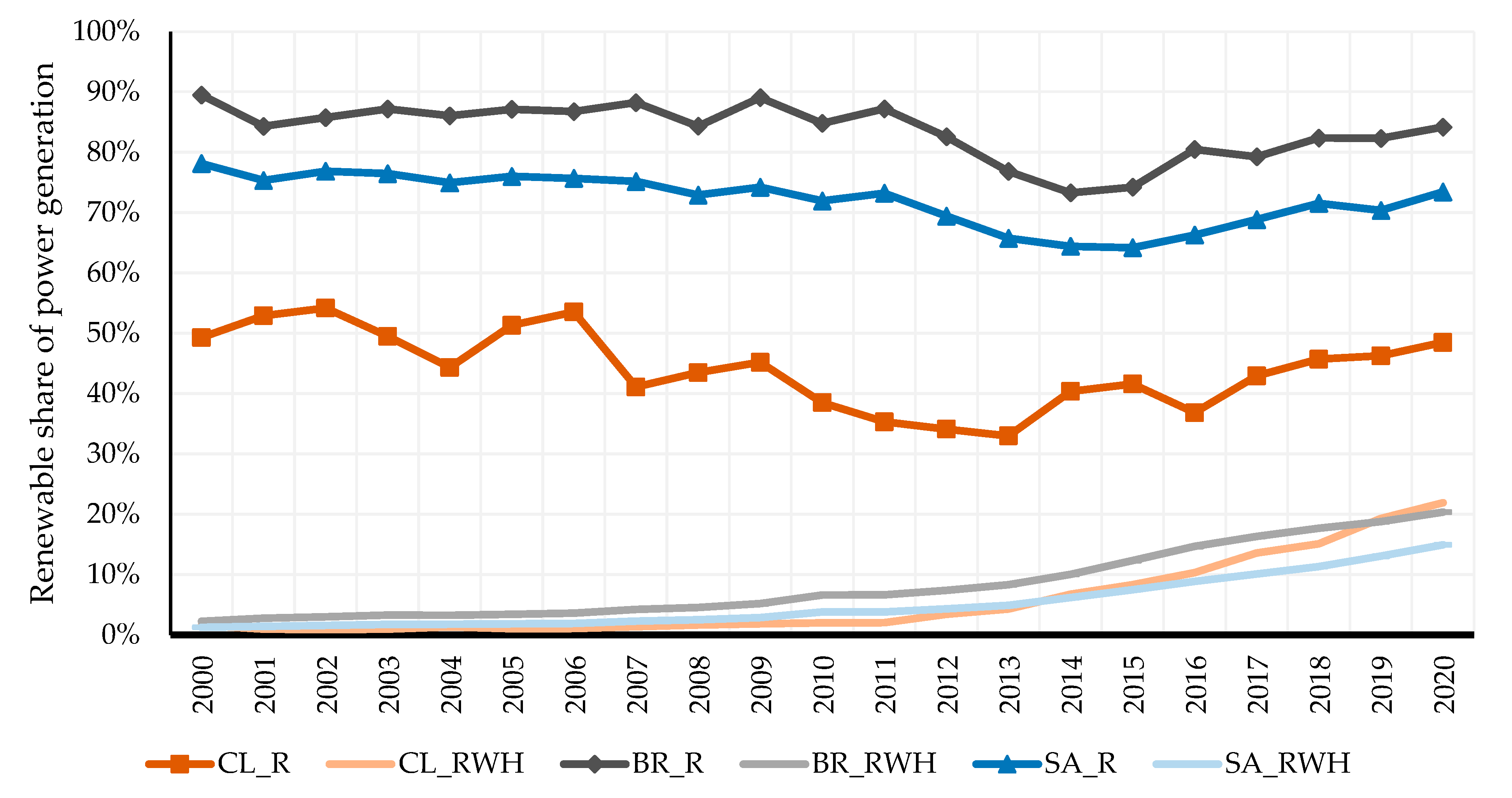
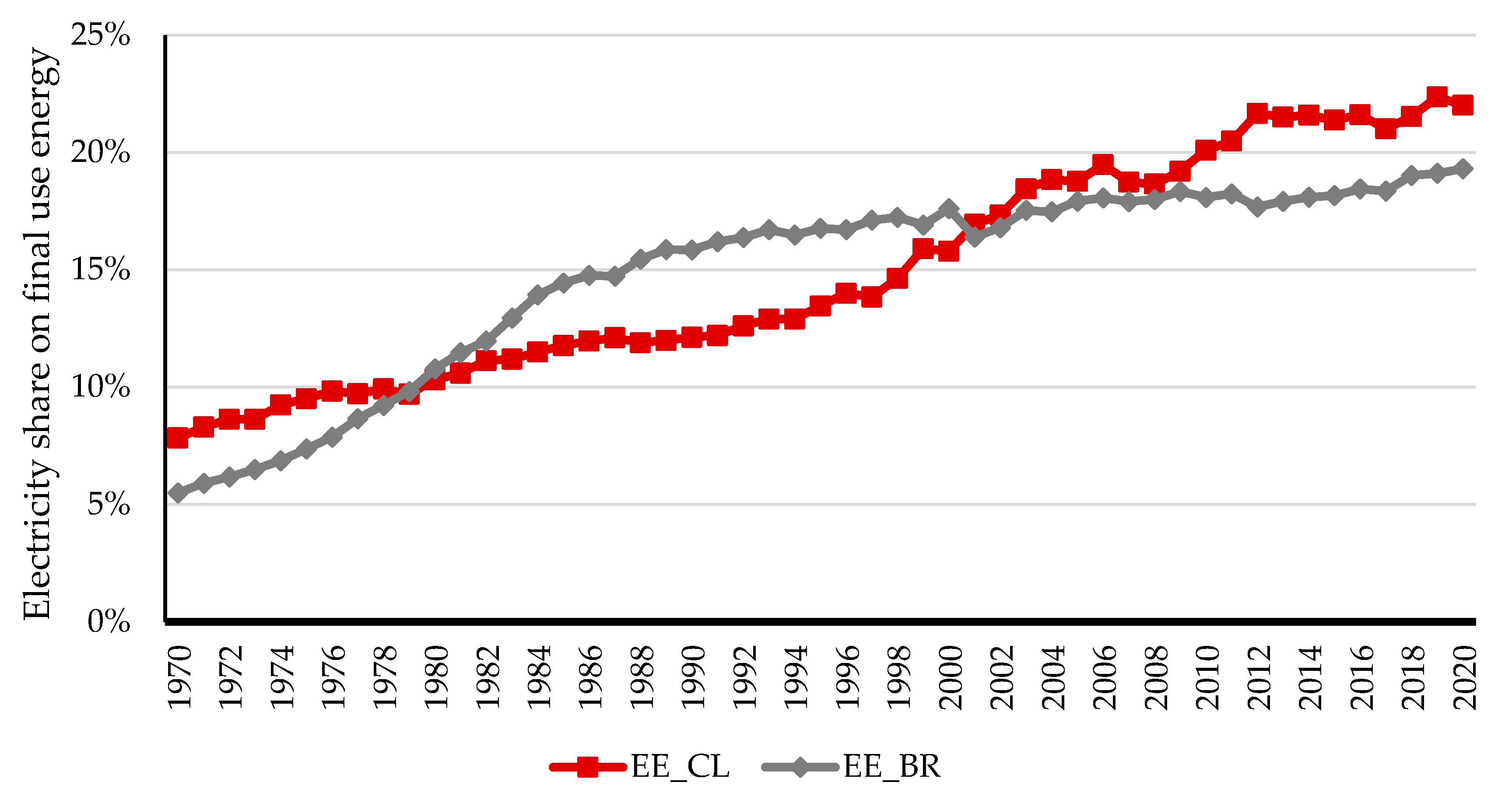
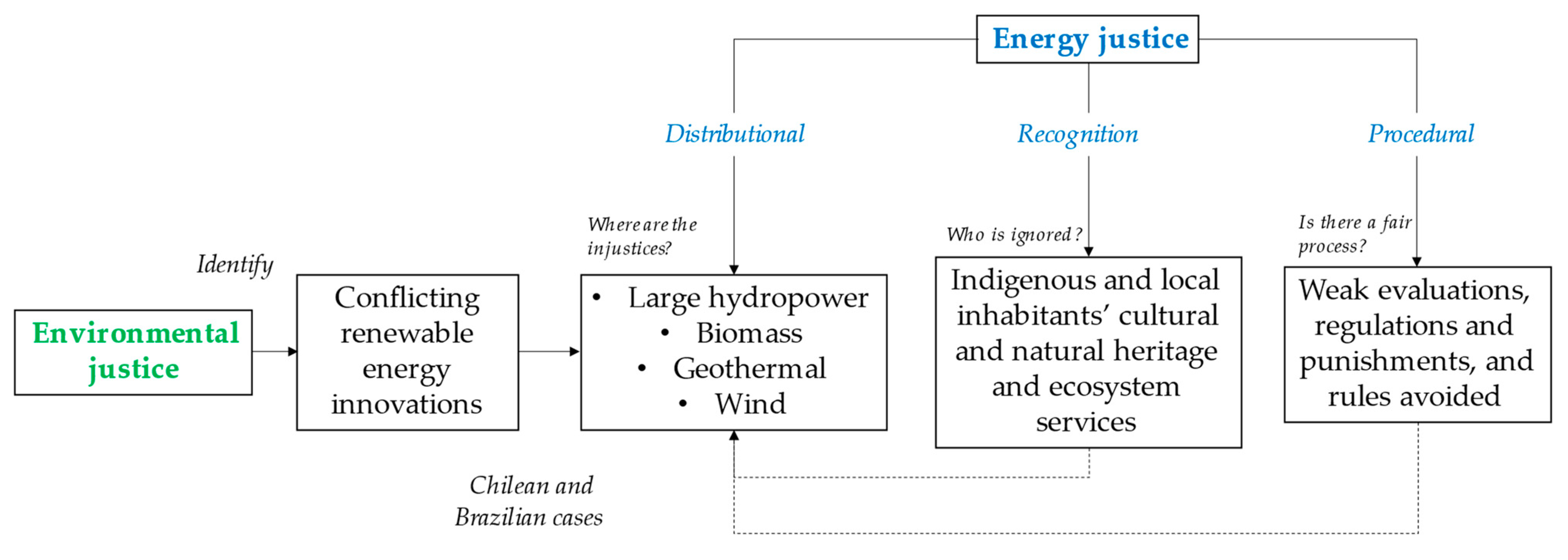
| Tenets | Evaluative Reach | Normative Reach |
|---|---|---|
| Distributional | Where are the injustices? | How should we solve them? |
| Recognition | Who is ignored? | How should we recognise this? |
| Procedural | Is there a fair process? | Which new processes? |
| Stage | Research Question(s) | Sources | Parameters | Criteria | Output | |
|---|---|---|---|---|---|---|
| 1 | Environmental justice (Searching renewable energy socio-ecological conflicts) | Which are the conflictive projects? | EJAtlas plus CEN database and ANEEL database |
|
| Projects’ names and sizes (listed) |
| Why did conflicts emerge? | Source of conflict | |||||
| How did conflicts emerge? | Impacts | |||||
| Where did conflicts emerge? | Region/State | |||||
| When did conflicts emerge? | Year | |||||
| 2 | Energy justice (Evaluating energy justice on listed projects) (a) | Where are the injustices? | Google Scholar | Language | English, Spanish, and Portuguese | Distributional evaluation |
| Who is ignored? | Recognition evaluation | |||||
| Is there a fair process? | Procedural evaluation | |||||
| SDG 7 | Item | Chile | Brazil |
|---|---|---|---|
| 2021 GDP per capita (current prices USD) | 16,503 | 7519 | |
| 7.1.1 | 2020 Share population with access to electricity (%) | ~100 | ~100 |
| 7.2.1 | 2019 Share of renewable energy in total final energy consumption (%) | 25.26 | 47.57 |
| 7.3.1 | 2019 Energy intensity level of primary energy (a) | 3.66 | 3.93 |
| 7.a.1 | 2019 International financial flows (millions of constant USD) | --- | 50.98 |
| 7.b.1 | 2020 Renewable electricity generation capacity (Watts per capita) | 669.287 | 705.901 |
| Tenets | Questions | Chilean Case |
|---|---|---|
| Distributional | Where are the injustices? | Atacama Desert (Antofagasta Region), Bío Bío (Bío Bío Region) and Maipo (Metropolitana Region) basins and Ñuble River (Ñuble Region) |
| Recognition | Who is ignored? | Indigenous and local inhabitants’ cultural and natural heritage and ecosystem services |
| Procedural | Is there a fair process? | Weak evaluations, regulations, and punishments for violating water access rights, entitlements, and land properties |
| Tenets | Questions | Brazilian Case |
|---|---|---|
| Distributional | Where are the injustices? | Brazilian Amazonas: Tocantins, Xingú, Teles Pires Uatumã, Madeira and Tapajós Rivers; Pelotas River (Rio Grande do Sul and Santa Catarina States); Cuiabá River (Mato Grosso State); Aimorés River (Minas Gerais); and Caetité (Bahía State) and Sirinhaém municipalities (Pernambuco State) |
| Recognition | Who is ignored? | Indigenous and local inhabitants’ cultural and natural heritage and ecosystem services |
| Procedural | Is there a fair process? | Weak evaluations and regulations, rules avoided and practically inexistent punishments |
| Tenets (Questions) | Chile | Brazil |
|---|---|---|
| Distributional (Where are the injustices?) |
|
|
| Recognition (Who is ignored?) | Indigenous and local inhabitants’ cultural and natural heritage and ecosystem services | Indigenous and local inhabitants’ cultural and natural heritage and ecosystem services |
| Procedural (Is there a fair process?) | Weak evaluations, regulations, and punishments for violating water access rights, entitlements, and land properties | Weak evaluations and regulations, rules avoided and practically non-existent punishments |
Disclaimer/Publisher’s Note: The statements, opinions and data contained in all publications are solely those of the individual author(s) and contributor(s) and not of MDPI and/or the editor(s). MDPI and/or the editor(s) disclaim responsibility for any injury to people or property resulting from any ideas, methods, instructions or products referred to in the content. |
© 2023 by the authors. Licensee MDPI, Basel, Switzerland. This article is an open access article distributed under the terms and conditions of the Creative Commons Attribution (CC BY) license (https://creativecommons.org/licenses/by/4.0/).
Share and Cite
Poque González, A.B.; Masip Macia, Y.; Ferreira, L.d.C.; Valdes, J. Socio-Ecological Controversies from Chilean and Brazilian Sustainable Energy Transitions. Sustainability 2023, 15, 1861. https://doi.org/10.3390/su15031861
Poque González AB, Masip Macia Y, Ferreira LdC, Valdes J. Socio-Ecological Controversies from Chilean and Brazilian Sustainable Energy Transitions. Sustainability. 2023; 15(3):1861. https://doi.org/10.3390/su15031861
Chicago/Turabian StylePoque González, Axel Bastián, Yunesky Masip Macia, Lúcia da Costa Ferreira, and Javier Valdes. 2023. "Socio-Ecological Controversies from Chilean and Brazilian Sustainable Energy Transitions" Sustainability 15, no. 3: 1861. https://doi.org/10.3390/su15031861
APA StylePoque González, A. B., Masip Macia, Y., Ferreira, L. d. C., & Valdes, J. (2023). Socio-Ecological Controversies from Chilean and Brazilian Sustainable Energy Transitions. Sustainability, 15(3), 1861. https://doi.org/10.3390/su15031861









